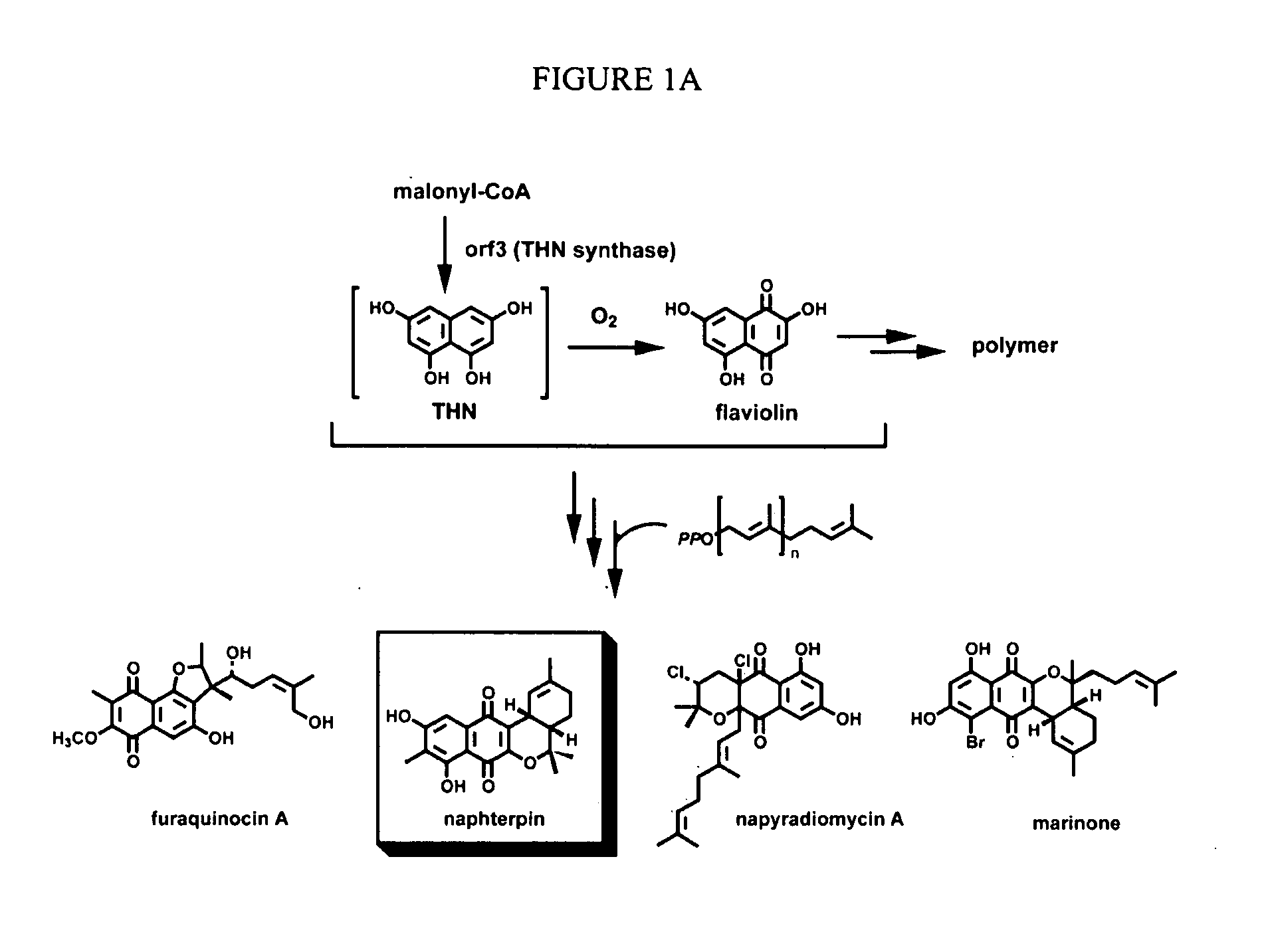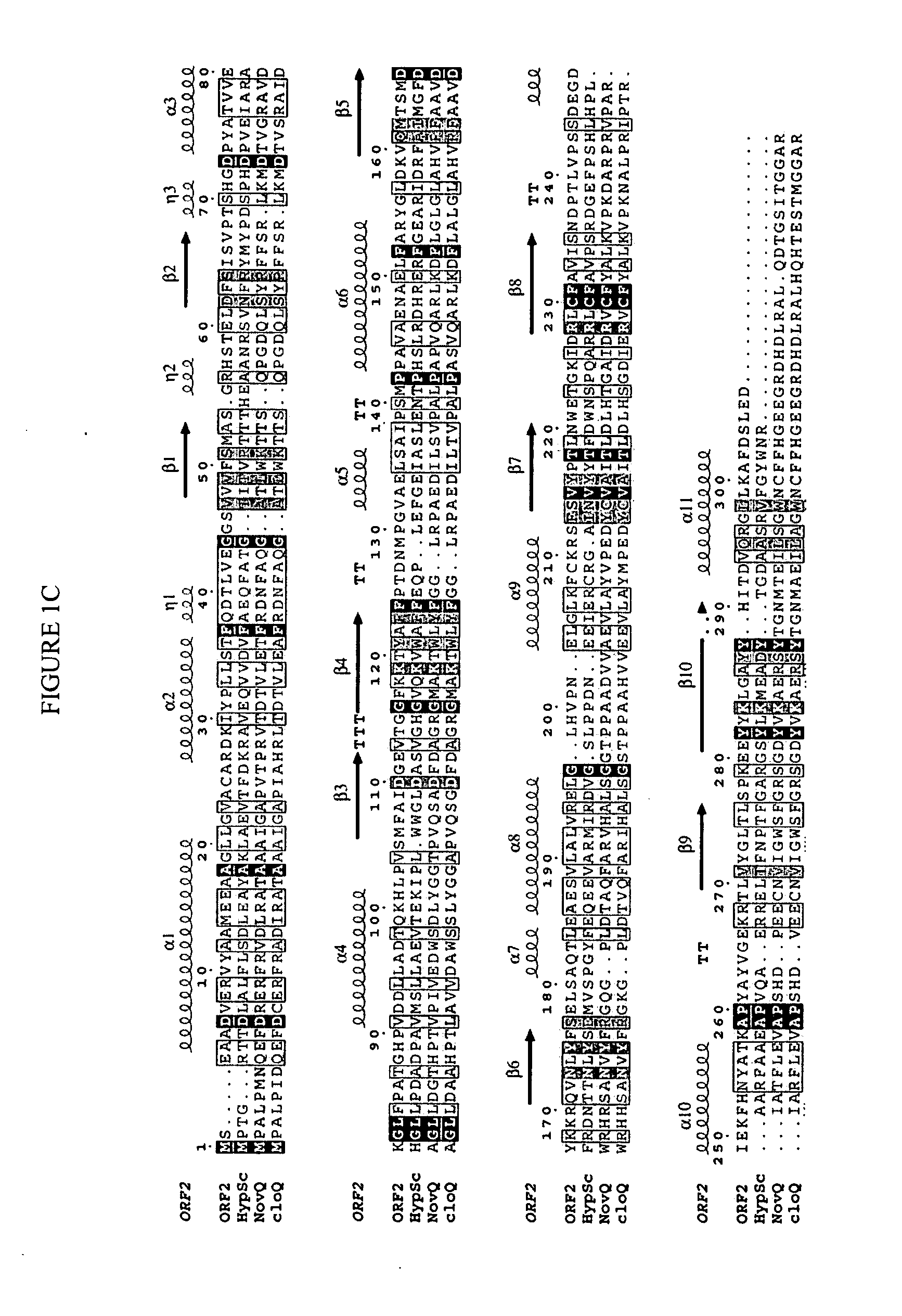Novel aromatic prenyltransferases, nucleic acids encoding same and uses therefor
a technology of nucleic acids and aromatic prenyltransferases, applied in the field of aromatic prenyltransferases and nucleic acids encoding same, can solve the problems of low yield, low regio- and enantio-selectivity, and notably scarce terpenoids
- Summary
- Abstract
- Description
- Claims
- Application Information
AI Technical Summary
Benefits of technology
Problems solved by technology
Method used
Image
Examples
example 1
Cloning of ORF2
[0237] A cosmid pCLC7 (see Takagi et al., J Bacteriol 182:41534157 (2000)), which contains the mevalonate pathway gene cluster and the flanking regions cloned from CL190, was sequenced. The DNA sequence of Orf2 was determined by standard techniques, and is set forth as SEQ ID NO:1. The amino acid sequence of Orf2 was deduced from the DNA sequence and is set forth as SEQ ID NO:2.
[0238] This sequencing revealed 3 new complete orfs, orf1, orf2, and orf3 and a partial orf4 in a 9.0 kb-BamHI-BamHI DNA fragment which contains mevalonate kinase and diphosphomevalonate decarboxylase (see pCL3301 in FIG. 6). To deduce function of each orf, a database search was done. The results are summarized in Table 2.
TABLE 2Most homologous proteins andORFsAmino acidstheir accession numbersORF1319 aaS. avermitilis RNA polymerase ECF-subfamily σ factor, AP005050ORF2307 aaS. coelicolor A3(2) protein,AL391041ORF3410 aaS. antibioticus type IIIpolyketide synthase, AB084489ORF4177 aaS. erythr...
example 2
Cloning, Expression and Purification of the ORF2 Gene
[0240] The orf2 gene from Streptomyces sp. strain CL190 (GenBank accession number AB187169) was cloned by PCR amplification of total genomic DNA from CL190 using oligonucleotides designed for ligation into the E. coli expression vector pQE30 (Qiagen), to generate the expression plasmid pQEORF2. PCR amplification of pQEORF2, using oligonucleotides designed for ligation into the E. coli expression vector pHIS8 (Jez et al., Biochemistry 39(5):890-902 (2000)) was carried out using the forward primer sequence:
(SEQ ID NO:35′-GGG GGG GGA TCC TCC GAA GCC GCT GAT GTC G-3′;BamHI site underlined),
[0241] and the reverse primer sequence:
(SEQ ID NO:45′-GGG GGG GAA TTC TCA GTC CTC CAG CGA GTC G-3′;EcoRI site underlined)
to generate the expression vector pHIS80RF2. Constructs of pHIS80RF2 were transformed into E. coli BL21 (DE3) from Novagen. Recombinant Orf2 protein was obtained and purified using a standard protocol described before Jez et...
example 3
Crystallization of Orf2
[0242] Initial crystals of the Orf2 protein (50 μm×30 μm×10 μm) were obtained by the vapor diffusion method at 4° C. 2 μl hanging drops containing a 1:1 mixture of a 15 mg·ml−1 protein with crystallization buffer (28% [w / v] PEG 4000, 0.3 M magnesium nitrate, 2 mM DL-dithiothreitol (DTT), 0.1 M PIPES pH 8.5) equilibrated over a 500 μl reservoir of the same solution produced small diffracting crystals overnight. Larger crystals were obtained by the macro-seeding technique in the same conditions. Crystals were stabilized by soaking briefly in a cryoprotectant solution (30% (w / v) PEG 4000, 15% (v / v) glycerol, 0.3 M magnesium nitrate, 2 mM DTT, 0.1 M TAPS, pH 8.5), and flash frozen in liquid nitrogen prior to data collection. Orf2 crystals belong to the P21212 space group with average unit cell dimensions of a=71 Å, b=92 Å, c=48 Å, α=β=γ=90°, and contain one monomer per asymmetric unit and a solvent content of 45%. Se-Met substituted crystals were obtained as des...
PUM
| Property | Measurement | Unit |
|---|---|---|
| volume | aaaaa | aaaaa |
| temperature | aaaaa | aaaaa |
| pH | aaaaa | aaaaa |
Abstract
Description
Claims
Application Information
 Login to View More
Login to View More - R&D
- Intellectual Property
- Life Sciences
- Materials
- Tech Scout
- Unparalleled Data Quality
- Higher Quality Content
- 60% Fewer Hallucinations
Browse by: Latest US Patents, China's latest patents, Technical Efficacy Thesaurus, Application Domain, Technology Topic, Popular Technical Reports.
© 2025 PatSnap. All rights reserved.Legal|Privacy policy|Modern Slavery Act Transparency Statement|Sitemap|About US| Contact US: help@patsnap.com



